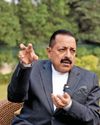
The statue of S.W.R.D. Bandaranaike, the former prime minister who led Sri Lanka through several political upheavals, stands on a pedestal at the iconic Galle Face Green, the famous city park near the presidential secretariat in Colombo. It was from here that the people of Sri Lanka started the movement to overthrow the powerful Rajapaksas two years ago. Today, however, an uneasy calm prevails on the streets of Colombo as Sri Lanka gets ready to elect its next president on September 21. Despite the presence of 39 candidates-a few of them offering some fairly revolutionary policy options-the 1.7 crore voters of Sri Lanka do not appear really excited.
President Ranil Wickremesinghe of the United National Party (UNP) is contesting as an independent, backed by a major section of legislators from former president Mahinda Rajapaksa's Sri Lanka Podujana Peramuna (SLPP). Also in the fray are opposition leader Sajith Premadasa, leftist leader Anura Kumara Dissanayake and Mahinda's son, Namal. Sajith's Samagi Jana Balawegaya (SIB) has aligned with some of the prominent parties and has the support of the Tamil and the Muslim minorities, who form 11 per cent and 9.7 per cent of the population, respectively. Anura is a Marxist-Leninist leader from the Janatha Vimukthi Peramuna (JVP), the main constituent of the National People's Power (NPP) coalition.
While Ranil, Sajith and Anura are the frontrunners, Namal, the youngest in the fray, has made the contest tough for them. He is the official SLPP candidate, but his chances of winning even half of the 69 lakh votes polled by his uncle Gotabaya Rajapaksa in 2019 appear remote.
Other important candidates include P. Ariyanethiran, the Tamil MP from the north, Nuwan Bopage, the activist lawyer who led the Aragalaya protest movement in 2022, and former military chief Sarath Fonseka.
This story is from the September 22, 2024 edition of THE WEEK India.
Start your 7-day Magzter GOLD free trial to access thousands of curated premium stories, and 9,000+ magazines and newspapers.
Already a subscriber ? Sign In
This story is from the September 22, 2024 edition of THE WEEK India.
Start your 7-day Magzter GOLD free trial to access thousands of curated premium stories, and 9,000+ magazines and newspapers.
Already a subscriber? Sign In

Is bridal wear on the wane?
So many guests walked out of Sabyasachi's grand 25th year celebration in Mumbai last weekend, a little confused, even outraged. How can India's most famous bridal wear designer not showcase a single bridal outfit? Guests were underwhelmed, or disappointed, unable to wrap their coiffed heads around the fact that India is changing, and fashion is now more than a lehenga.

The wedding goes slim
So Jeet Adani is to have a 'traditional and simple' wedding sans celebrities or media glare. His father told the press that the auspicious date was finalised during a visit by the Adani family to the Mahakumbh in Prayagraj, where the muhurat was decided in the presence of vedic scholars.

INTO THE MOCHA-VERSE
Did Pantone get it right with its colour of the year 2025?

The art is in the right place
Joining a growing league of India's privately-owned museums is Sarmaya, a modern space that chronicles historic journeys

New words for old feelings
At a recent literary festival in Pune, its curator, the author Manjiri Prabhu, challenged me to prove my love of words by coining a few new ones. Inspired by the English language's habit of borrowing freely from the world's languages, I essayed these:

OIL AND MORE
India cannot be a spectator to what is unravelling in West Asia, say experts

We hope India will support two-state solution and help rebuild Gaza
War-torn Gaza, once home to Yasser Arafat, dreamt of self governance for the Palestinian territories. This time, its people are looking towards the Palestinian Authority to play a bigger role in helping implement the phased Israel-Hamas ceasefire, rebuilding territory and uniting Palestinians.

BACK TO BROMANCE
India's strategy will be to convince President Trump that there is no daylight between him and Prime Minister Modi in advancing their shared goals

Next industrial revolution will be driven by biotechnology and bio-economy
IN AUGUST 2024, the Union cabinet approved the BioE3 policy—Biotechnology for Economy, Environment and Employment, a framework policy to leverage biotechnology for India's economic growth, environmental sustainability and employment generation. It prioritises bio-manufacturing initiatives in various sectors like biopolymers, smart proteins, bio-therapeutics, climate-resilient agriculture, and marine and space research.

AMERICAN NIGHTMARE
With his strident anti-immigrant rhetoric and actions, Donald Trump is killing the American dream for both documented and undocumented workers. Indians, especially the H-1B visa holders and aspirants, could suffer the most under the new administration's policies